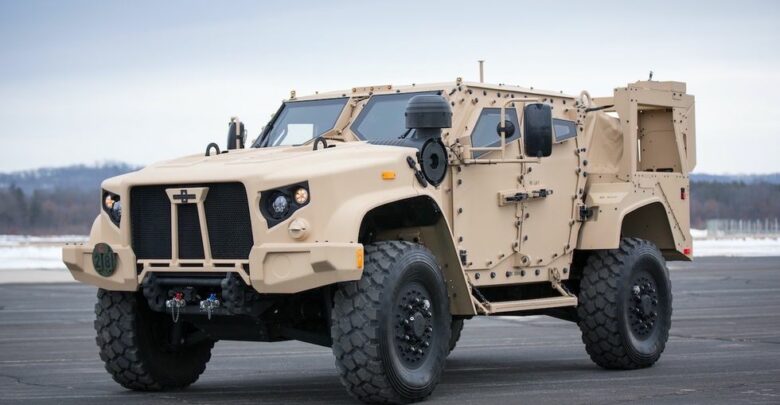
President Joe Biden’s administration has been bullish over Americans switching over to electric vehicles (EV) as part of the US’ commitment to supporting climate change objectives.
If the federal government really wants to put its money where its mouth is, it should implore the Department of Defense to transition to electric vehicles.
A DoD adoption of EVs wouldn’t represent technology for technology’s sake or putting agendas above military effectiveness. Instead, it is about pursuing platforms that buyback efficiencies in maintenance and manpower to better use DoD funding.
The US Army has already incorporated the development and employment of non-tactical electric vehicles into its long-range force structure and climate strategies. Other branches should follow suit.
Electric Vehicles’ Cost Saving Potential
Discussions about range and durability will come into play when discussing military uses of EVs. Therefore, initial military EV adoption should focus on support vehicles that service non-tactical operational or maintenance purposes.
EVs require less periodic maintenance with longer service intervals than their internal combustion engine counterparts. Fewer moving parts mean mechanical failures are less frequent and often easier to identify and replace.
The potential cost savings on in-service maintenance and repair, in addition to EV adoption signaling a top-down commitment to combatting climate change, make EVs too valuable a proposition not to be considered.
Electric Support Vehicles
The US military should fully embrace the EV revolution and start the phased replacement of support equipment, beginning with aircraft tow tractors and aviation ground support equipment.
Despite being more advanced, EVs are not as complex as internal combustion engine vehicles and their associated transmission requirements. Moreover, EVs have instantly available torque and can often tow higher ratio loads than their non-electrical counterparts.
The most extensive counter-argument to the widespread adoption of EVs is the lack of charging infrastructure to support long-distance trips. However, this downside is not a factor if you discuss a shipboard environment and can be easily rectified at ground-based, permanent military aviation facilities.
Ships present an opportunity for the US Navy to replace diesel-powered support vehicles with electrical ones. Conventional and nuclear-powered surface ships have no shortage of available electrical power.
EVs on Aircraft Carriers
The first target for replacement should be aviation ground support equipment onboard aircraft carriers and big deck amphibious ships. There already are commercially available options, which provide opportunities to test and evaluate potential platforms in a much timelier and more streamlined process than from scratch designs.
Electric ground support equipment on an aircraft carrier would require less periodic maintenance, reducing required man-hours and onboard hazardous material (HAZMAT) to support operations.
Additionally, EVs don’t require fuel, which reduces fuel expenditure and lowers the aggregate number of flight deck or hangar deck refueling evolutions, which present the opportunity for a HAZMAT spill.

These benefits would allow more fuel onboard a carrier to support flight operations and either reduce manning requirements or allow current manning levels to support other needs, reducing the total man-hours expended during at-sea operations.
A reduction in HAZMAT and fuel requirements would also allow the use of current storage capacity for different provisions or to conduct configuration changes for future platforms that reduce the required storage and fuel tank levels.
And finally, the smaller overall size and tighter turning abilities may provide more aircraft or other equipment to be unloaded to the supporting ship.
Winning America’s Future Wars
Adopting electric vehicles presents an opportunity to introduce vehicles three times as efficient as legacy internal combustion engine vehicles that require significantly less maintenance, part support, and hazardous material.
As the DoD continues to be challenged by manning and funding constraints, it is imperative to procure systems that make more efficient use of resources. And where fuel savings may not “move the needle,” the buyback of man-hours and maintenance costs likely will.
The EV revolution is sweeping across the American automobile industry. The Department of Defense should embrace it to utilize technology that can increase the efficiency of operations in support of fighting and winning America’s future wars.
 Michael Knickerbocker (@saltystrategist) is a United States Navy Surface Warfare Officer and is currently a Federal Executive Fellow at the Clements Center for National Security at the University of Texas at Austin, conducting independent research into naval equities impacting current national security situations.
Michael Knickerbocker (@saltystrategist) is a United States Navy Surface Warfare Officer and is currently a Federal Executive Fellow at the Clements Center for National Security at the University of Texas at Austin, conducting independent research into naval equities impacting current national security situations.
His research focuses on technology adaptation into maritime strategy, maritime trade security assessments, and risk identification.
The views expressed are those of the individual writing them and do not reflect the official positions of the US Department of Defense, Department of the Navy, or the University of Texas at Austin.
The views and opinions expressed here are those of the author and do not necessarily reflect the editorial position of The Defense Post.
The Defense Post aims to publish a wide range of high-quality opinion and analysis from a diverse array of people – do you want to send us yours? Click here to submit an op-ed.











